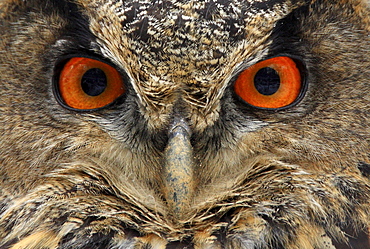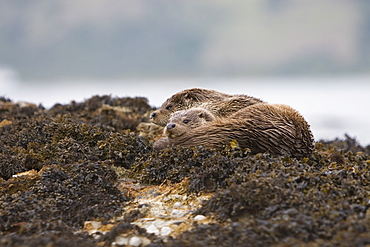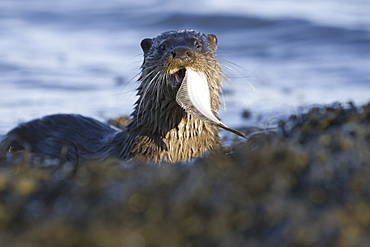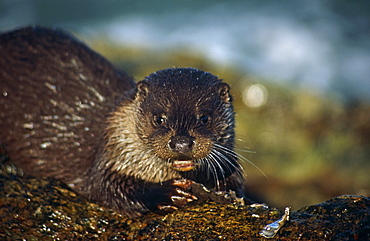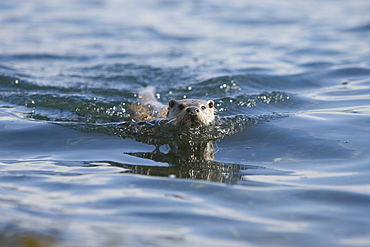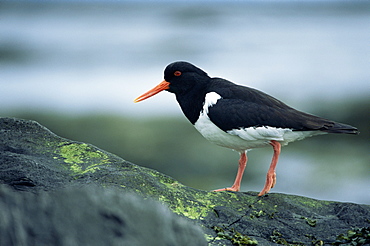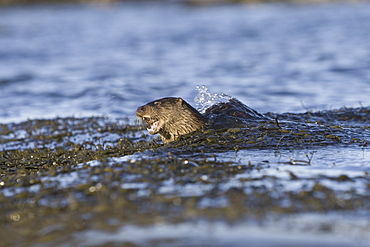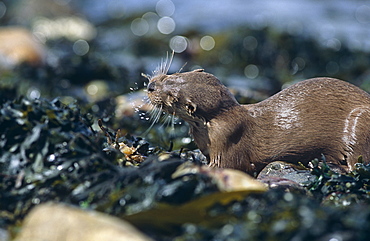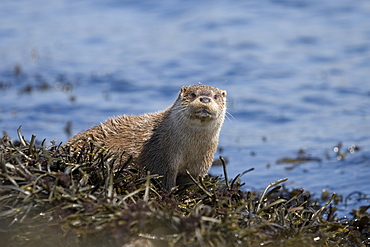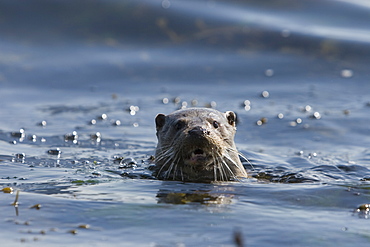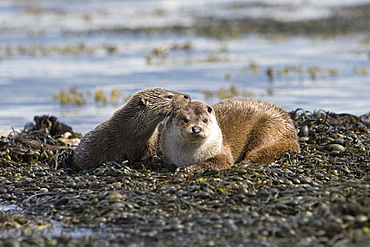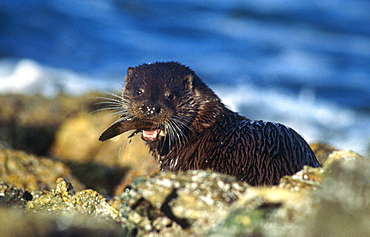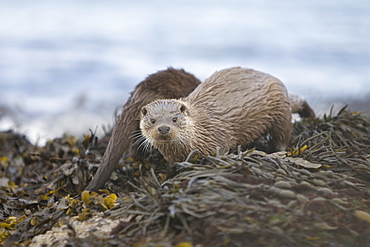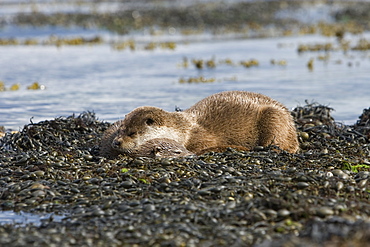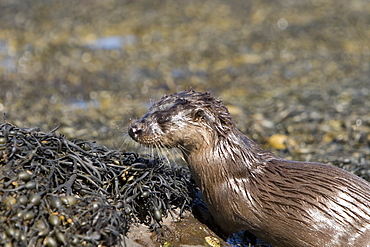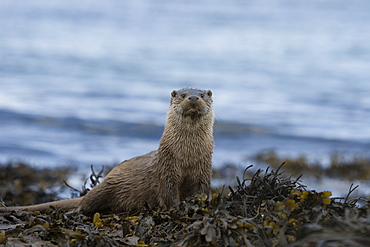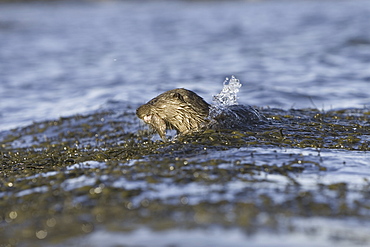Results
« Previous 1 2
109 results found
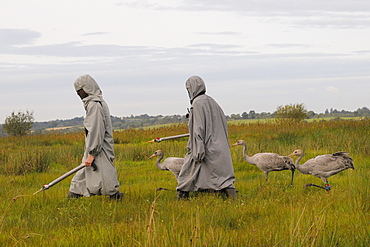
Surrogate parents leading recently reintroduced young common cranes (Eurasian cranes) (Grus grus) over the Somerset Levels, Somerset, England, United Kingdom, Europe
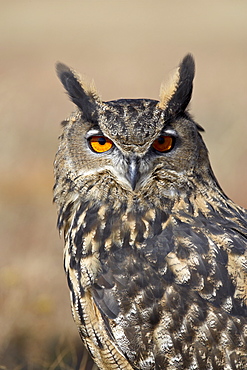
Eurasian eagle owl (Bubu bubo) in captivity, Boulder County, Colorado, United States of America, North America
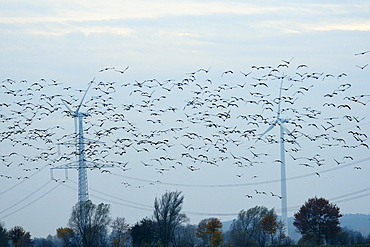
Common cranes (Eurasian cranes) (Grus grus) and pink footed geese (Anser brachyrhyncus) fly near pylons and wind turbines, Germany, Europe
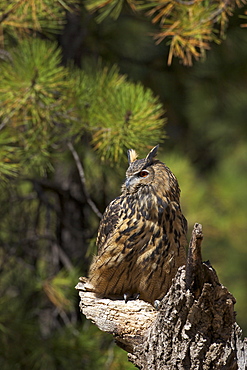
Eurasian eagle-owl (Bubo bubo), Bearizona Wildlife Park, Williams, Arizona, United States of America, North America
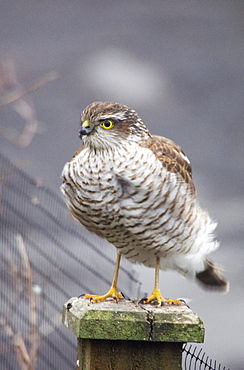
A female Eurasian sparrowhawk (Accipiter nisus) on a garden fence post in Ambleside, Cumbria, England, United Kingdom, Europe

Common or Eurasian crane flock (Grus grus) flying close to wind farm and natural gas plant, autumn, near Diepholz, Lower Saxony, Germany.

White willow (Salix alba) tree with base of trunk almost chewed through by Eurasian beaver (Castor fiber), Narew marshes, Podlaskie, Poland. MORE INFO: Beaver activity is crucial in keeping Poland's ancient marshes open and free of encroaching bushes and trees and their dams also help to maintain high water levels.
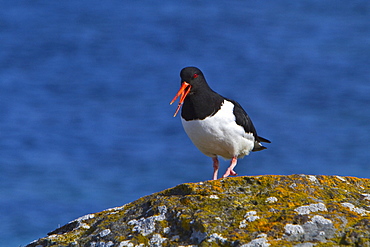
Adult Eurasian Oystercatcher (Haematopus ostralegus ostralegus) in full breeding plumage at Isfjardardjup, Northwestern Iceland
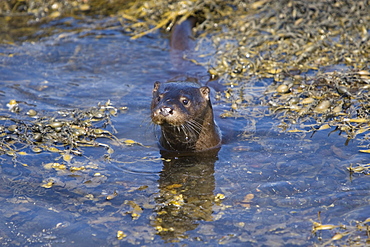
Eurasian river otter (Lutra lutra) foraging in and among the seaweed. Otters on Scotland's west coast and islands have adapted well to making a living in the marine environment. Hebrides, Scotland (RR)
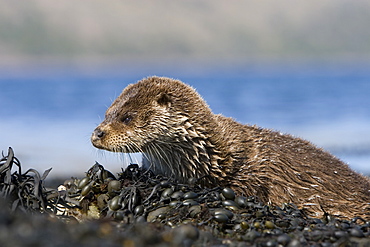
Eurasian river otter (Lutra lutra) resting on seaweed. Otters spend a great deal of time resting ashore, usually near to the water's edge. This time is spent sleeping and preening fur etc. Visits ashore may also be to find fresh water to drink. Hebrides, Scotland
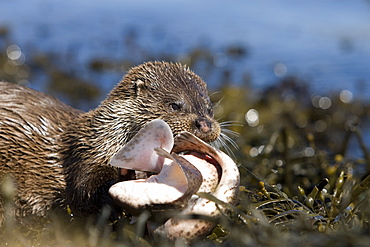
Eurasian river otter (Lutra lutra) eating Greater spotted dogfish (Scyliorhinus stellaris). The otter took only the innards of the dogfish by opening a short section of skin behind the pectoral fin (see images under 'Greater spotted dogfish'). The rest of the fish, still alive, was left on the shore and never retrieved. Perhaps the tough shark skin and battling fish are too much work when other food is plentiful? Hebrides, Scotland
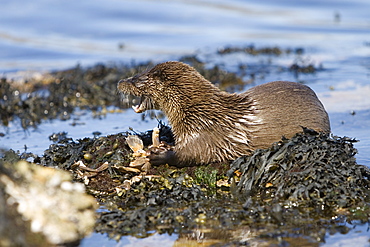
Eurasian river otter (Lutra lutra) eating a large crab. Large fish and crabs are difficult to constrain and eat in the water so are often brought ashore. Otters will sometimes swim realtively long distances in order to do so. Hebrides, Scotland
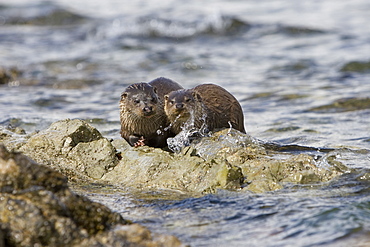
Eurasian river otter (Lutra lutra) mother eating fish with cub closeby. The cub tried unsuccessfully to obtain some of its mother's catch. Hebrides, Scotland
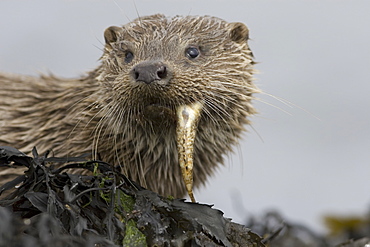
Eurasian river otter (Lutra lutra) eating fish. Otters have adapted well to the marine environment but require sources of fresh water to drink and to clean fur. Hebrides, Scotland
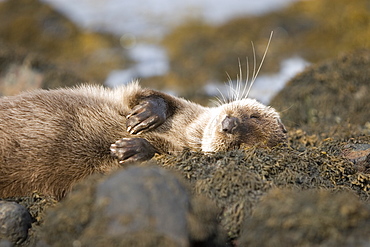
Eurasian river otter (Lutra lutra) resting in the seaweed and rocks. Otters spend a great deal of time resting, usually close to the water's edge or on rocks just offshore. This time is spent sleeping and preening fur etc. Notice the recent injuries sustained by this otter around the head and neck area. Hebrides, Scotland
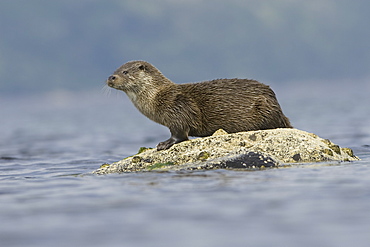
Eurasian river otter (Lutra lutra). Otters in western Scotland have adapted well to life in a marine environment, though proximity to sources of fresh water is essential. Hebrides, Scotland
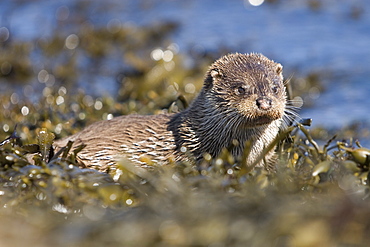
Eurasian river otter (Lutra lutra) having caught Greater spotted dogfish (Scyliorhinus stellaris). The otter took only the innards of the dogfish by opening a short section of skin behind the pectoral fin (see images under 'Greater spotted dogfish'). Hebrides, Scotland (RR)
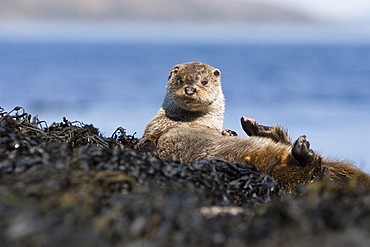
Eurasian river otter (Lutra lutra) resting on seaweed. Otters spend a great deal of time resting ashore, usually near to the water's edge. This time is spent sleeping and preening fur etc. Visits ashore may also be to find fresh water to drink. Hebrides, Scotland
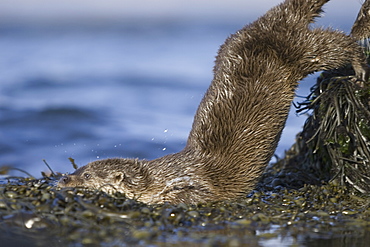
Eurasian river otter (Lutra lutra). Otters in western Scotland have adapted well to life in a marine environment, though proximity to sources of fresh water is essential. Hebrides, Scotland
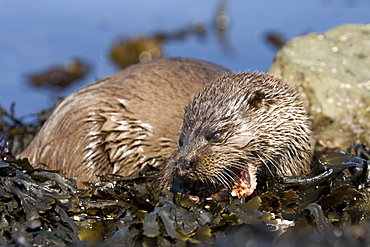
Eurasian river otter (Lutra lutra) eating fish, long-spined bullhead (Taurulus bubalis). Hebrides, Scotland
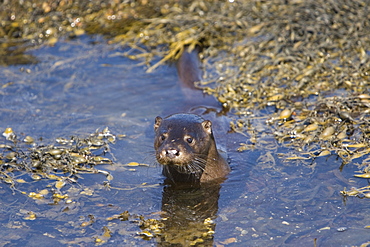
Eurasian river otter (Lutra lutra) foraging in and among the seaweed. Otters on Scotland's west coast and islands have adapted well to making a living in the marine environment. Hebrides, Scotland
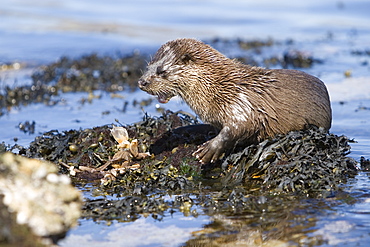
Eurasian river otter (Lutra lutra) eating a large crab. Large fish and crabs are difficult to constrain and eat in the water so are often brought ashore. Otters will sometimes swim realtively long distances in order to do so. Hebrides, Scotland
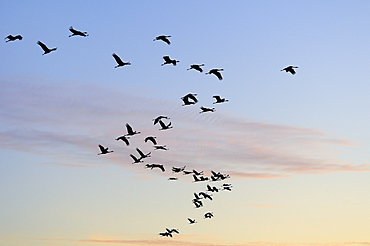
Common or Eurasian crane (Grus grus) flocks flying from roost site at sunrise, silhouetted against dawn sky, autumn migration period, Rugen-Bock-Region, Mecklenburg-Vorpommern, Germany.
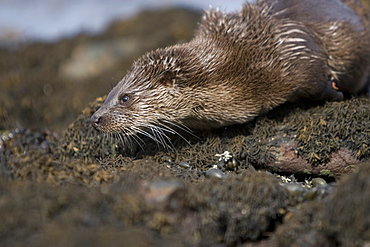
Eurasian river otter (Lutra lutra) resting in the seaweed and rocks. Otters spend a great deal of time resting, usually close to the water's edge or on rocks just offshore. This time is spent sleeping and preening fur etc. Notice the recent injuries sustained by this otter around the head and neck area. Hebrides, Scotland
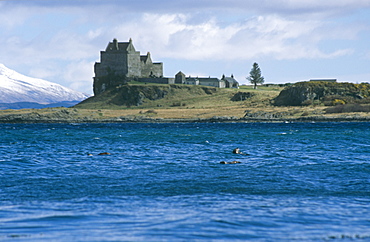
Eurasian river otters (Lutra lutra) by Duart castle. Duart Castle has been the home of the Clan Maclean since the 14th century. Isle of Mull, Scotland
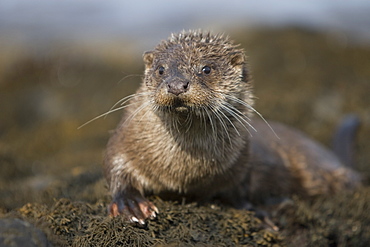
Eurasian river otter (Lutra lutra) resting in the seaweed and rocks. Otters spend a great deal of time resting, usually close to the water's edge or on rocks just offshore. This time is spent sleeping and preening fur etc. Notice the recent injuries sustained by this otter around the head and neck area. Hebrides, Scotland
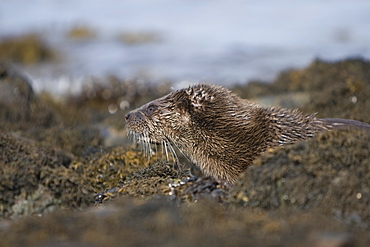
Eurasian river otter (Lutra lutra) resting in the seaweed and rocks. Otters spend a great deal of time resting, usually close to the water's edge or on rocks just offshore. This time is spent sleeping and preening fur etc. Notice the recent injuries sustained by this otter around the head and neck area. Hebrides, Scotland
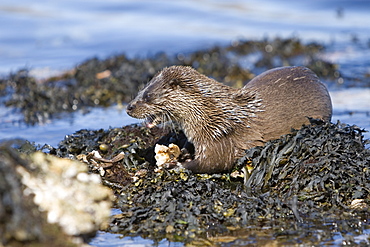
Eurasian river otter (Lutra lutra) eating a large crab. Large fish and crabs are difficult to constrain and eat in the water so are often brought ashore. Otters will sometimes swim realtively long distances in order to do so. Hebrides, Scotland
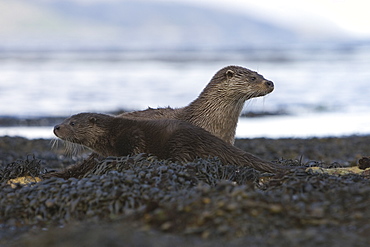
Eurasian river otter (Lutra lutra) mother and cub. Cubs often have darker fur than their mothers and for the first few months are much more 'buoyant' in the water. Hebrides, Scotland
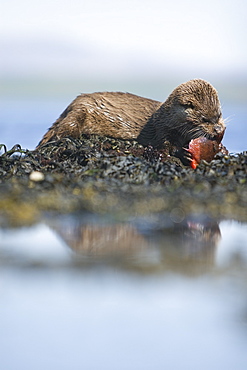
Eurasian river otter (Lutra lutra) eating a male lumpsucker (Cyclopterus lumpus) fish, also known as a sea hen or scarclagger. Hebrides, Scotland
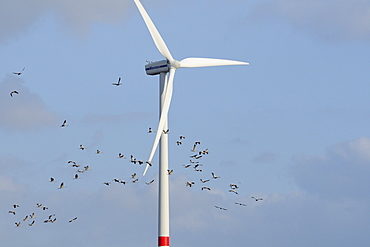
Common or Eurasian crane (Grus grus) flock flying close to wind turbine, near Diepholz, Lower Saxony, Germany.
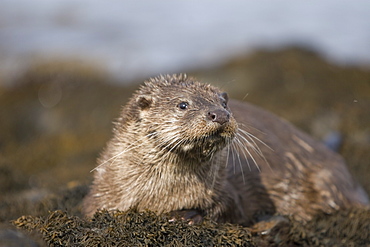
Eurasian river otter (Lutra lutra) resting in the seaweed and rocks. Otters spend a great deal of time resting, usually close to the water's edge or on rocks just offshore. This time is spent sleeping and preening fur etc. Notice the recent injuries sustained by this otter around the head and neck area. Hebrides, Scotland
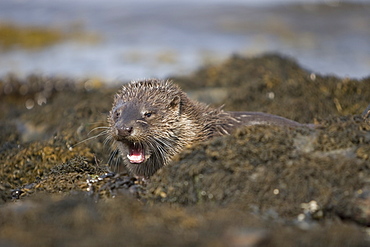
Eurasian river otter (Lutra lutra) resting in the seaweed and rocks. Otters spend a great deal of time resting, usually close to the water's edge or on rocks just offshore. This time is spent sleeping and preening fur etc. Notice the recent injuries sustained by this otter around the head and neck area. Hebrides, Scotland
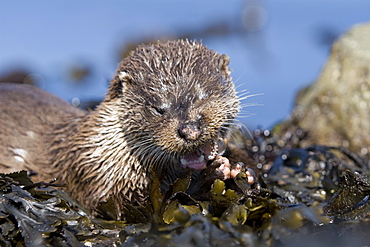
Eurasian river otter (Lutra lutra) eating fish, long-spined bullhead (Taurulus bubalis). Hebrides, Scotland
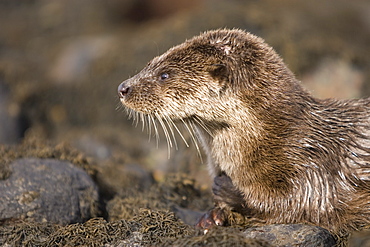
Eurasian river otter (Lutra lutra) resting in the seaweed and rocks. Otters spend a great deal of time resting, usually close to the water's edge or on rocks just offshore. This time is spent sleeping and preening fur etc. Notice the recent injuries sustained by this otter around the head and neck area. Hebrides, Scotland
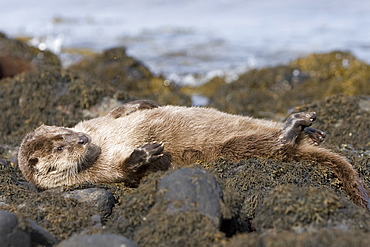
Eurasian river otter (Lutra lutra) resting in the seaweed and rocks. Otters spend a great deal of time resting, usually close to the water's edge or on rocks just offshore. This time is spent sleeping and preening fur etc. Notice the recent injuries sustained by this otter around the head and neck area. Hebrides, Scotland
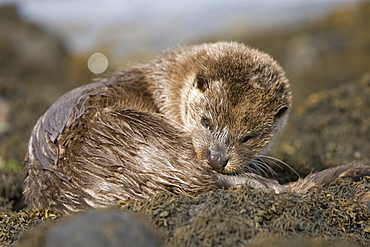
Eurasian river otter (Lutra lutra) resting in the seaweed and rocks. Otters spend a great deal of time resting, usually close to the water's edge or on rocks just offshore. This time is spent sleeping and preening fur etc. Notice the recent injuries sustained by this otter around the head and neck area. Hebrides, Scotland
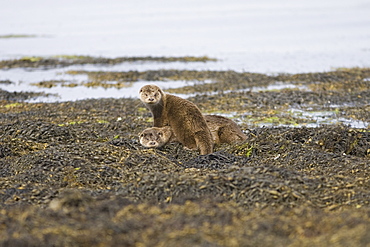
Eurasian river otters (Lutra lutra) resting. Otters take regular breaks during their foraging activities, often choosing high points or islets just offshore in order to sleep, preen and play. Hebrides, Scotland
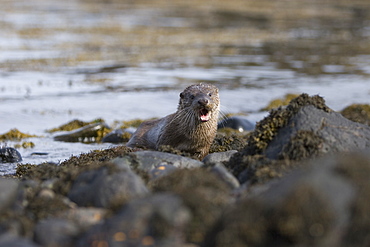
Eurasian river otter (Lutra lutra) foraging in and among the seaweed. Otters on Scotland's west coast and islands have adapted well to making a living in the marine environment. Hebrides, Scotland
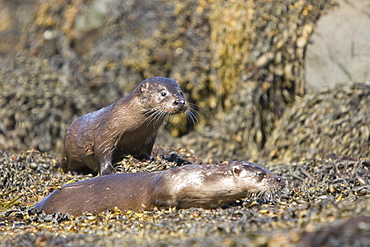
Pair of Eurasian river otters (Lutra lutra) foraging in and among the seaweed. Otters on Scotland's west coast and islands have adapted well to making a living in the marine environment. Hebrides, Scotland
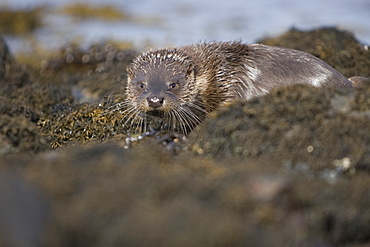
Eurasian river otter (Lutra lutra) resting in the seaweed and rocks. Otters spend a great deal of time resting, usually close to the water's edge or on rocks just offshore. This time is spent sleeping and preening fur etc. Notice the recent injuries sustained by this otter around the head and neck area. Hebrides, Scotland

Eurasian river otter (Lutra lutra). Otters in western Scotland have adapted well to life in a marine environment, though proximity to sources of fresh water is essential. Hebrides, Scotland
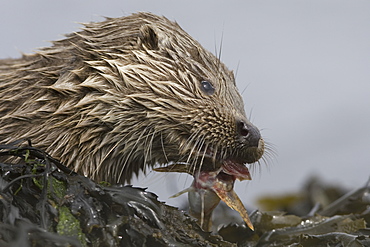
Eurasian river otter (Lutra lutra) eating fish. Otters have adapted well to the marine environment but require sources of fresh water to drink and to clean fur. Hebrides, Scotland
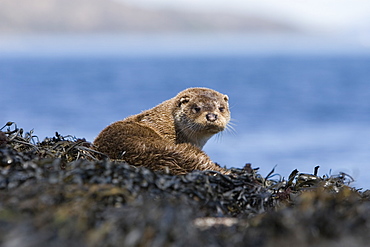
Eurasian river otter (Lutra lutra) resting on seaweed. Otters spend a great deal of time resting ashore, usually near to the water's edge. This time is spent sleeping and preening fur etc. Visits ashore may also be to find fresh water to drink. Hebrides, Scotland
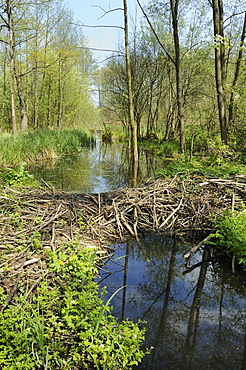
Eurasian beaver (Castor fiber) dam on drainage channel in Narew marshes, Podlaskie, Poland. MORE INFO: Beaver activity benefits much other wetland wildlife by helping to maintain high water levels in Poland's ancient marshes and swamp forests.
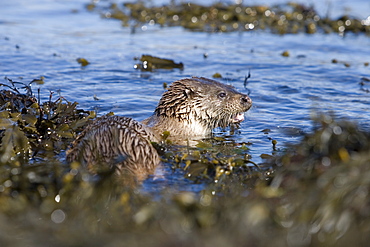
Eurasian river otter (Lutra lutra) having caught Greater spotted dogfish (Scyliorhinus stellaris). The otter took only the innards of the dogfish by opening a short section of skin behind the pectoral fin (see images under 'Greater spotted dogfish'). The rest of the fish, still alive, was left on the shore and never retrieved. Perhaps the tough shark skin and battling fish are too much work when other food is plentiful? Hebrides, Scotland
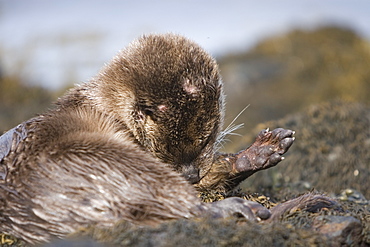
Eurasian river otter (Lutra lutra) resting in the seaweed and rocks. Otters spend a great deal of time resting, usually close to the water's edge or on rocks just offshore. This time is spent sleeping and preening fur etc. Notice the recent injuries sustained by this otter around the head and neck area. Hebrides, Scotland
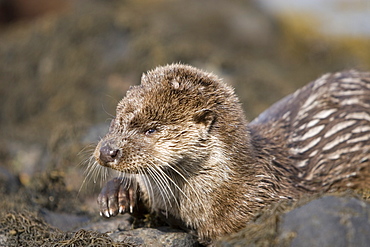
Eurasian river otter (Lutra lutra) resting in the seaweed and rocks. Otters spend a great deal of time resting, usually close to the water's edge or on rocks just offshore. This time is spent sleeping and preening fur etc. Notice the recent injuries sustained by this otter around the head and neck area. Hebrides, Scotland
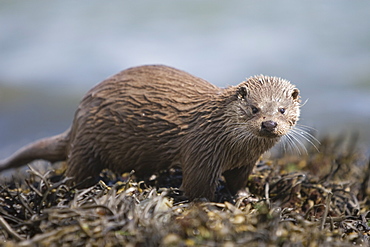
Eurasian river otter (Lutra lutra) in the marine environment to which they have adapted so successfully. Hebrides, Scotland.
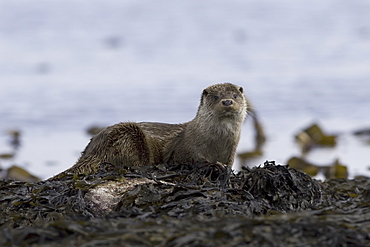
Eurasian river otter (Lutra lutra) resting. Otters take regular breaks during their foraging activities, often choosing high points or islets just offshore in order to sleep, preen and play. Hebrides, Scotland
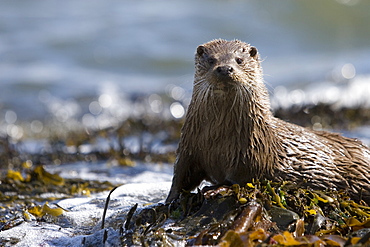
Eurasian river otter (Lutra lutra) in the marine environment to which they have adapted so successfully. Hebrides, Scotland.
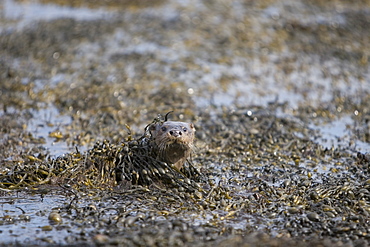
Eurasian river otter (Lutra lutra) foraging in and among the seaweed. Otters on Scotland's west coast and islands have adapted well to making a living in the marine environment. Hebrides, Scotland
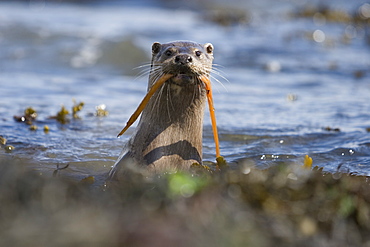
Eurasian river otter (Lutra lutra) catching and eating snake pipefish (Entelerus aequoreus). Hebrides, Scotland.
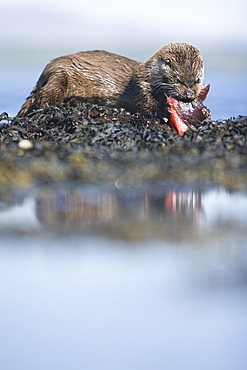
Eurasian river otter (Lutra lutra) eating a male lumpsucker (Cyclopterus lumpus) fish, also known as a sea hen or scarclagger. Hebrides, Scotland
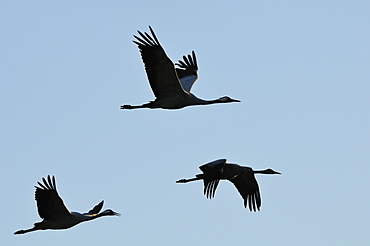
Common or Eurasian cranes (Grus grus) family of 3 flying from roost at dawn, silhouetted against sky, autumn migration period, Rugen-Bock-Region, Mecklenburg-Vorpommern, Germany.
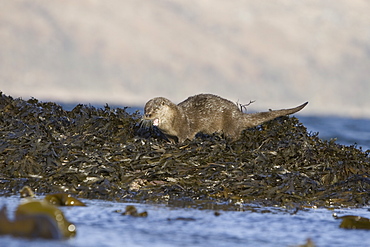
Eurasian river otter (Lutra lutra) sprainting on high point. The spraint is a method of marking territory and high points are a favoured location, even those washed by tides.
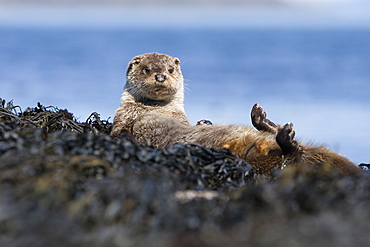
Eurasian river otter (Lutra lutra) resting on seaweed. Otters spend a great deal of time resting ashore, usually near to the water's edge. This time is spent sleeping and preening fur etc. Visits ashore may also be to find fresh water to drink. Hebrides, Scotland

Adult Eurasian Wigeon (Anas penelope) in breeding plumage on Lake Myvatn, Iceland. MORE INFO American and Eurasian Wigeons have been known to hybridize in the wild.
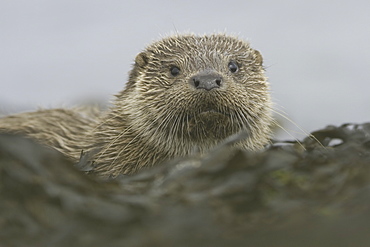
Eurasian river otter (Lutra lutra). Otters in western Scotland have adapted well to life in a marine environment, though proximity to sources of fresh water is essential. Hebrides, Scotland
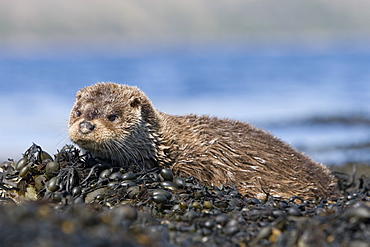
Eurasian river otter (Lutra lutra) resting on seaweed. Otters spend a great deal of time resting ashore, usually near to the water's edge. This time is spent sleeping and preening fur etc. Visits ashore may also be to find fresh water to drink. Hebrides, Scotland
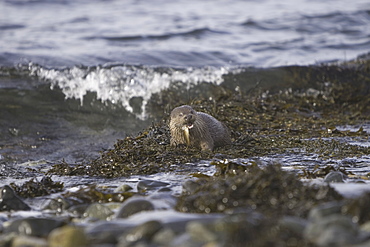
Eurasian river otter (Lutra lutra) eating fish. Otters in western Scotland have adapted well to life in a marine environment, though proximity to sources of fresh water is essential. Hebrides, Scotland
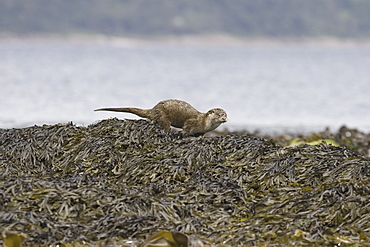
Eurasian river otter (Lutra lutra) sprainting on high point. The spraint is a method of marking territory and high points are a favoured location, even those washed by tides.
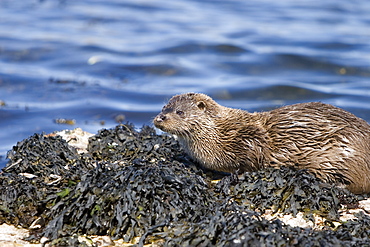
Eurasian river otter (Lutra lutra) resting on seaweed. Otters spend a great deal of time resting ashore, usually near to the water's edge. This time is spent sleeping and preening fur etc. Visits ashore may also be to find fresh water to drink. Hebrides, Scotland
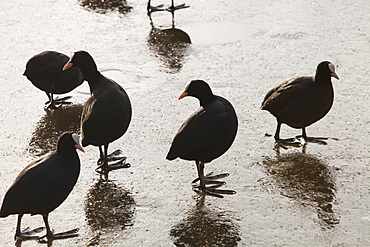
Eurasian coot on ice at Martin Mere bird reserve near Ormskirk, Lancashire, England, United Kingdom, Europe

Family of Eurasian river otters (Lutra lutra) sprainting on high point. The spraint is a method of marking territory and high points are a favoured location, even those washed by tides.
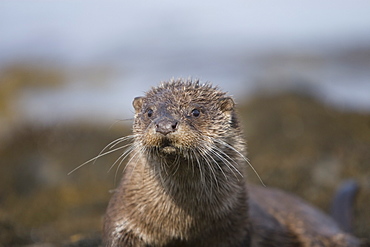
Eurasian river otter (Lutra lutra) resting in the seaweed and rocks. Otters spend a great deal of time resting, usually close to the water's edge or on rocks just offshore. This time is spent sleeping and preening fur etc. Notice the recent injuries sustained by this otter around the head and neck area. Hebrides, Scotland
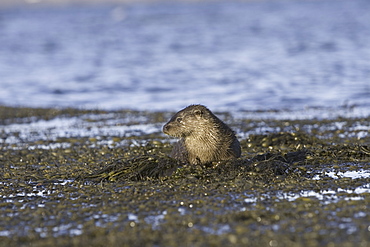
Eurasian river otter (Lutra lutra). Otters in western Scotland have adapted well to life in a marine environment, though proximity to sources of fresh water is essential. Hebrides, Scotland
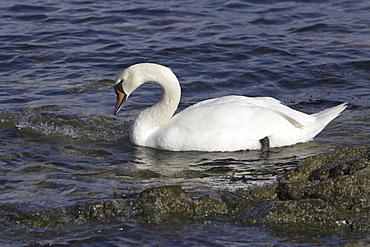
Mute swan (Cygnus olor) at sea. Most people might associate swans with a freshwater environment but they can also be seen in a marine setting. Hebrides, Scotland
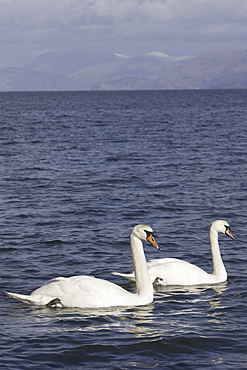
Mute swan (Cygnus olor) at sea, Ben Nevis in background. Most people might associate swans with a freshwater environment but they can also be seen in a marine setting. Hebrides, Scotland

Mute swan (Cygnus olor) at sea. Most people might associate swans with a freshwater environment but they can also be seen in a marine setting. Hebrides, Scotland

Five Common or Eurasian cranes (Grus grus) flying from roost, silhouetted against blue sky, autumn migration period, Rugen-Bock-Region, Mecklenberg-Vorpommern, Germany.
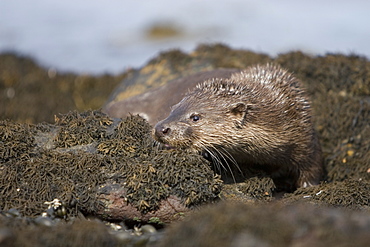
Eurasian river otter (Lutra lutra) resting in the seaweed and rocks. Otters spend a great deal of time resting, usually close to the water's edge or on rocks just offshore. This time is spent sleeping and preening fur etc. Notice the recent injuries sustained by this otter around the head and neck area. Hebrides, Scotland

Pair of Eurasian river otters (Lutra lutra) foraging in and among the seaweed. Otters on Scotland's west coast and islands have adapted well to making a living in the marine environment. Hebrides, Scotland
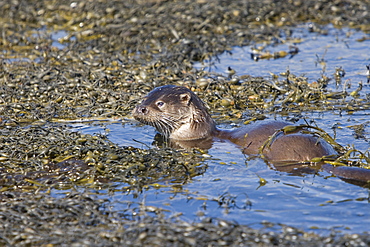
Eurasian river otter (Lutra lutra) foraging in and among the seaweed. Otters on Scotland's west coast and islands have adapted well to making a living in the marine environment. Hebrides, Scotland

Adult Eurasian Wigeon (Anas penelope) in breeding plumage on Lake Myvatn, Iceland. MORE INFO American and Eurasian Wigeons have been known to hybridize in the wild.
